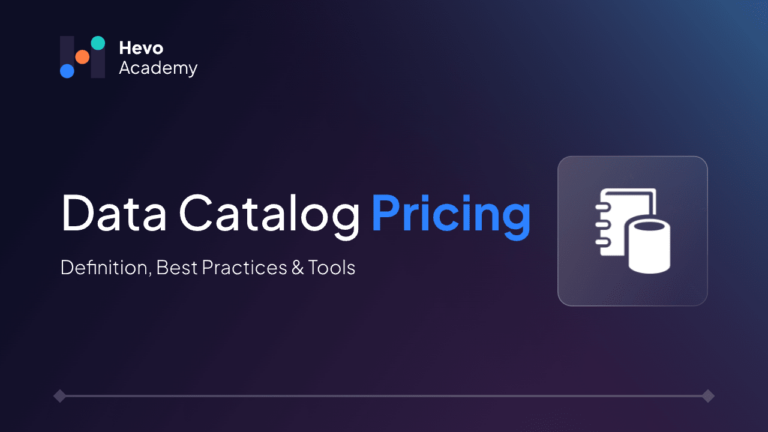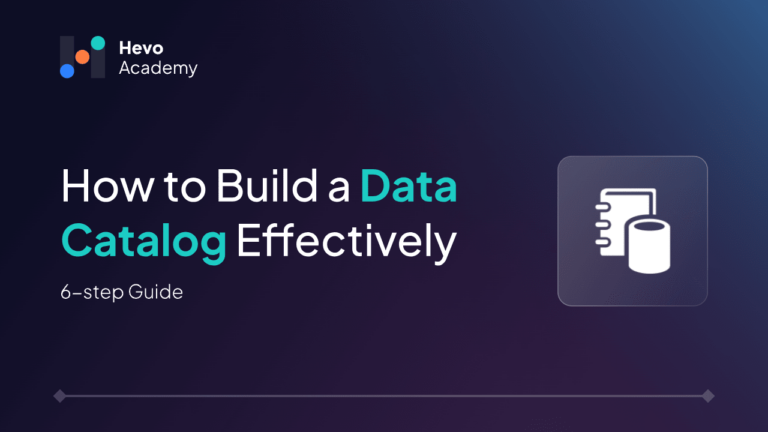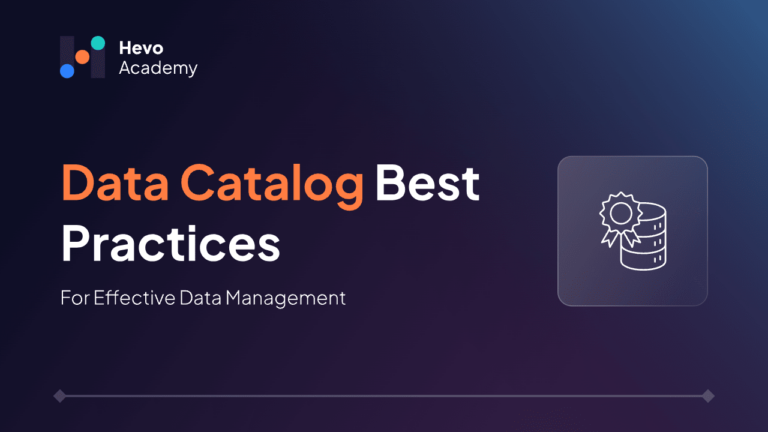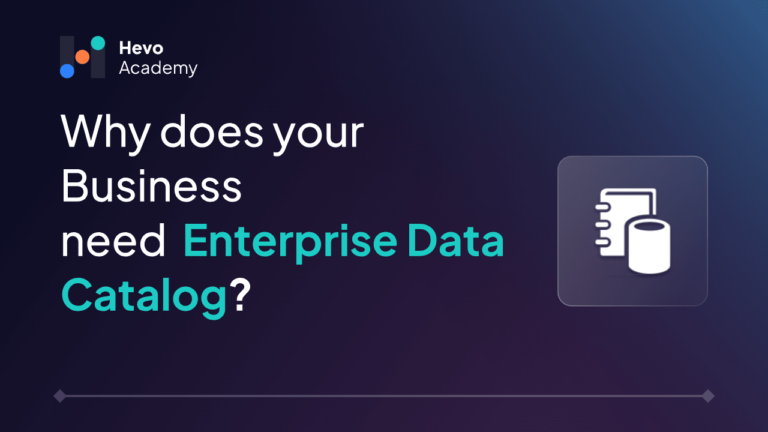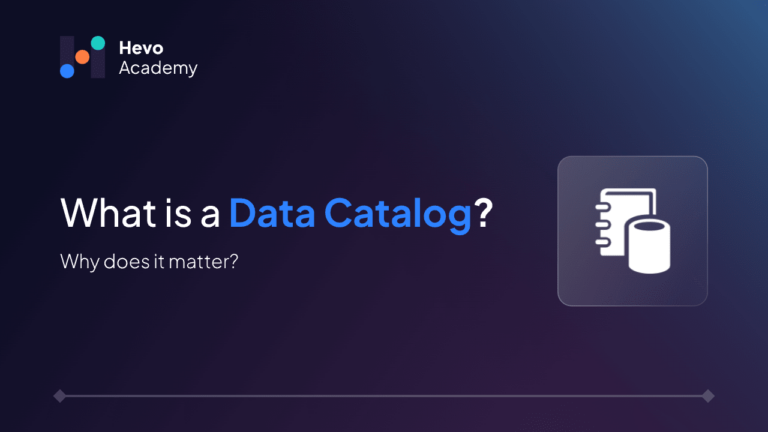Got billed but didn’t know about the hidden charges? Increased traffic or advanced functionalities might be driving up your data catalog costs.
Table of Contents
The market is flooded with data catalog tools, and picking one that fits your needs without breaking the bank is critical. It is crucial to comprehend the important factors of data catalog pricing, such as the number of users, data size, and functionalities, in order to maximize the value of your investment. The cost is significantly determined by factors such as the amount of users, data volume, and scalability. Therefore, thoroughly evaluating every aspect will result in optimal returns on your investment.
This article examines the seven factors that affect data catalog pricing, how they impact expenses and provides useful suggestions to assist in finding the right balance between cost and value for your requirements.
What is included in a Data Catalog?
A data catalog serves as a complete directory for all data in a business, allowing people to discover and understand different data sets by providing details about each data source, such as where it is located, who owns it, and how it can be used. For instance, Google Cloud Data Catalog is a tool that helps users easily locate and manage their data on Google Cloud Platform.
Looking for the best ETL tools to connect your data sources? Rest assured, Hevo’s no-code platform helps streamline your ETL process. Try Hevo and equip your team to:
- Integrate data from 150+ sources(60+ free sources).
- Simplify data mapping with an intuitive, user-friendly interface.
- Instantly load and sync your transformed data into your desired destination.
Choose Hevo for a seamless experience and know why Industry leaders like Meesho say- “Bringing in Hevo was a boon.”
Get Started with Hevo for FreeWhat benefits can a Data Catalog offer to your company?
As organizations grow, the amount of data they possess also grows. Having a data catalog implemented allows your team to save time and resources by easily finding and accessing data, ultimately increasing productivity. Improving the efficiency and precision of data retrieval can help you gain a competitive edge and improve your decision-making skills. It also enhances teamwork between departments by simplifying the sharing of data.
All of these factors are essential in order to maintain the efficiency, organization, and competitiveness of your business.
Who should use a data catalog?
Whether you are a data analyst who needs to quickly find and understand data, a data scientist who requires relevant datasets for building models, or a business user who wants to make informed decisions, a data catalog integrated into your organization’s data architecture will always help you:
- Easily locate and access the data you need, saving time and effort.
- Obtain an understanding of data lineage, context, and relationships to give data greater significance and practicality.
- Uphold strict standards of data precision and uniformity, essential for trustworthy analysis and reporting.
- Improve communication and sharing of data between teams, dismantling barriers and promoting a culture driven by data.
- Make sure to follow data governance and privacy rules to lower the chance of data misuse risks.
Are you keen on improving the integration of your data catalog? Explore further: Data Catalog Best Practices for Effective Data Management
Data Catalog Pricing Overview
When you choose to start using a data catalog, understanding the pricing models around data catalogs becomes pivotal. Why? Because it helps you budget effectively and ensures you get the best value for your investment.
Before we understand the key factors affecting your data catalog pricing, it’s important to be aware of the potential costs and budget implications. This ensures you can plan effectively and avoid unexpected expenses. Hence, don’t get swayed to simply integrate but know how and which pricing model works best for you.
Begin by inquiring about the details that assist in outlining your particular needs, like:
- What is the number of users requiring access to the data catalog?
- What is the total amount of data that needs to be organized?
- What features are essential for our particular circumstances?
- Do we prefer a cloud-based or on-site solution instead?
- What type of assistance and expert services are required?
- Is it essential to integrate with other tools and systems?
and many others..
Learn more about must-have data catalog features for your organization before choosing one.
Top 7 Factors that influence the Data Catalog pricing
After preparing your key requirement checklist, you can now investigate the various data catalog pricing models that vary depending on different factors.
1. Number of Users
The pricing may depend on how many users are using the data catalog. For instance, a possible scenario is a monthly fee of $50 for each individual user. If you have 10 users, your monthly expenses will come to $500. This model is perfect for companies that have a consistent amount of users.
2. Data Volume
Certain models calculate fees based on the volume of data stored in the catalog. As an example, a service provider could bill $0.10 for each gigabyte of data used. Having 1,000 GB of data results in a monthly payment of $100. This model is advantageous for organizations with less data.
3. Features and Functionality
Special features such as AI-generated insights or customized integrations may impact the pricing. A scenario might involve a simple package priced at $500 per month and a more sophisticated option costing $1500 monthly. If you require functions such as automatic tagging of metadata or advanced search options, you may choose the premium plan.
4. Type of Deployment
Prices for on-premises and cloud-based solutions may vary in terms of their structures. Subscription-based cloud services may cost around $1,000 per month, whereas on-premises solutions could require a one-time payment of $20,000 for a license. Cloud-based solutions provide flexibility and reduced initial expenses, while on-premises options may be more economical in the future.
5. Support and Services
Extra assistance and expert services can also affect expenses. For instance, having around-the-clock support could increase your monthly plan cost by an additional $200. If your team needs significant training or continuous support, this may be an important consideration.
6. Integration Capabilities
Having the capacity to connect with various tools and systems can impact pricing as well. For example, incorporating a CRM system could increase your plan by $300 per month. This is crucial for organizations that depend on uninterrupted data transfer within.
7. Scalability
Certain providers provide pricing that can be adjusted according to your expansion. An illustration could be a plan that begins at $500 per month for a maximum of 10 users and increases to $2,000 per month for a maximum of 100 users. This model is advantageous for expanding organizations expecting a rise in data catalog usage.
Additional/ Hidden Costs in Data Cataloging
While you might be told upfront about the key factors affecting your data catalog pricing, you probably don’t want to be in a situation where you get billed for factors you weren’t even aware of. In that case, you must always ask if any provider has any hidden or additional charges. This ensures transparency and helps you budget accurately.
Below are the primary hidden expenses in data cataloging that can impact the pricing of your data catalog:
- Fees for Data Ingestion: The cost linked with transferring data into the catalog. It becomes powered up as processing and integrating data may demand considerable resources.
- Storage Expenses: In addition to the original amount of data, there may be additional costs for storing data. This incurs costs as infrastructure is needed to store vast amounts of data.
- API Usage Fees: Fees may apply for utilizing APIs to integrate the data catalog with other systems. The cost is determined by the quantity of API requests made.
- Customization Charges: Additional fees may apply for tailoring the data catalog to meet specific requirements. This happens because custom development demands additional effort and resources.
- Training and Onboarding Fees: Costs may be associated with the training and onboarding services provided at the beginning. These fees are applied to compensate for the time and resources invested in preparing your team.
- Support and Maintenance Fees: Additional expenses may arise from premium support and maintenance services, surpassing the scope of basic support. These fees are imposed to guarantee uninterrupted, top-notch service.
- Compliance and Security Costs: Expenses may be required to ensure that your data catalog complies with security and regulatory standards. Maintaining data integrity and security requires these components.
Popular Data Catalog Tools and Their Pricing Models
Let’s explore how some popular data catalog pricing looks like, what is unique about their offering, and what is their cost-to-value ratio:
| Tool | Base Platform Costs | User Licensing | Trial and Free Versions | Enhancements and Add-Ons | Customer Support | User Feedback | USP |
| Alation | Starts at $40 per user per month (billed annually) | Pricing varies based on the number of users, with different tiers for regular users and administrators | Offers a trial period to test the tool before committing | Includes optional features like advanced analytics and AI capabilities | Provides robust customer support with various service levels | Users appreciate its collaborative features and strong metadata management | Known for its strong data governance capabilities and intuitive user interface |
| Collibra | Pricing available upon request | Flexible pricing based on user roles and number of users | Offers a trial period for evaluation | Includes modules for enhanced security and compliance | Highly rated for its comprehensive support services | Users value its scalability and integration capabilities | Offers comprehensive data governance and stewardship functionalities |
| Informatica | Pricing available upon request | Pricing varies based on user roles and data volume | Provides a trial period to explore features | Offers advanced data integration and management features | Known for its reliable and extensive support | Users appreciate its powerful data lineage and data quality tools | Provides extensive data integration and management features |
| data.world | Custom pricing based on features and usage | Flexible pricing based on user roles and data volume | Offers a freemium model to test basic features | Includes AI-driven insights and knowledge graph capabilities | Praised for its responsive and helpful support team | Users find its interface user-friendly and appreciate the AI-driven insights | Utilizes knowledge graph architecture for enhanced data discovery and context |
| Qlik Catalog | From $35 per user per month (billed annually) | Pricing varies based on user roles and number of users | Offers a trial period to test the tool | Provides advanced data lineage visualization and quality management | Known for effective customer support and training services | Users find it effective for creating a unified view of data across the organization | Excels in data lineage visualization and data quality management |
Tips to Reduce Data Cataloging Costs
So far, we have learned how various factors affect the data catalog pricing model and how we also need to be aware of any additional or hidden charges. But still, sometimes it gets difficult to understand why our bills are getting bigger and bigger. For instance, unexpected API usage charges can significantly increase costs.
Worry not, we have jotted down seven tips on how data cataloging costs can be minimized:
- Regularly review and adjust the number of user licenses to match actual usage.
- Keep track of API calls to avoid unexpected charges and optimize usage patterns.
- Utilize free tiers or trial versions for testing and initial deployment.
- Implement automated data discovery to reduce manual efforts and associated costs.
- Minimize the number of data sources to reduce integration and maintenance costs.
- Engage in negotiations with vendors to secure better pricing or discounts.
- Conduct regular audits to identify and eliminate unused or redundant data assets.
Conclusion
As various players are bombarding the data catalog market, the intricacies of data catalog pricing are set to increase. This makes it essential to keep the following factors in mind:
- Number of Users: The price goes up with an increased quantity of users.
- Data Volume: Increased amounts of data can lead to increased costs for both storage and processing.
- Features and Functionality: Improved functionalities typically lead to an increased price.
- Deployment Type: How you implement a system, whether on-premises, in the cloud, or via a hybrid method, can affect costs in different ways.
- Support and Services: Premium support and additional services can add to the cost.
- Integration Capabilities: Seamless integration with existing systems may require additional investment.
- Scalability: Ensure the solution can scale with your growing data needs without exorbitant costs.
Don’t forget to explicitly ask your provider about any additional or hidden data catalog pricing. This helps to avoid unexpected charges and better manage your budget.
Given the complexity of factors that must be considered while selecting a data catalog pricing, following just step-by-step instructions can be overwhelming due to the massive terms and conditions the data catalog tools may possess. That’s where Hevo Data professionals come in. We strategize, plan, and manage the entire data integration process, ensuring seamless and efficient data management. With our support, you can focus on deriving insights and making informed decisions rather than getting bogged down by data integration complexities.
Connect with us today to transform your data integration experience and achieve more with your data.
Frequently Asked Questions
1. Does Microsoft have a data catalog tool?
Yes, Microsoft offers Microsoft Purview. It aims to help organizations discover, manage, and govern data across different environments. This provides insights into data usage and lineage, making data governance more effective.
2. What is an example of a data catalog?
Informatica Cloud Data Governance and Catalog is an example. These tools provide metadata, data lineage, and quality information, to help their users understand and trust their data. Additionally, it supports data discovery and collaboration, enhancing data-driven decision-making.
3. Who needs a data catalog?
Data analysts, scientists, stewards, and business users need data catalogs. They streamline data discovery and understanding, enhancing decision-making and productivity.
4. How do you create a data catalog?
Steps to create a data catalog:
-Identify data sources to be cataloged.
-Define metadata standards to ensure consistency.
-Select a catalog tool that fits your needs.
-Integrate data sources with the tool.
-Regularly update the catalog to keep it accurate and useful.
